The Permian-Triassic Riftogen Rocks in the Norilsk Area (NW Siberian Province): Geochemistry and Their Possible Link with PGE-Cu-Ni Mineralization
Abstract
:1. Introduction
2. Brief Information about the Geology of the Area
3. Objects and Methods
4. Results
4.1. Volcanic Sequence in the Vologochan Syncline
4.2. Volcanic Sequence in the Khikey River Valley
4.3. Volcanic Sequence in Mount Sunduk
4.4. Variations in Tuff-Lavas Structure
4.5. Geochemical Features of Igneous Rocks
4.5.1. The Rock Compositions of the Ivakinsky, Syverminsky, and Gudchikhinsky Formations
4.5.2. The Rock Compositions of the Khakanchansky and Tuklonsky Formations
4.5.3. The Rock Compositions of the Nadezhdinsky Formation
4.5.4. Compositions of Intrusive Rocks
4.5.5. Metals in Volcanic and Intrusive Rocks
5. Discussion
6. Conclusions
- For the first time, the structural and geochemical variations along the strike of the Ivakinsky, Syverminsky, Gudchikhinsky, Khakanchansky, Tuklonsky, Nadezhdinsky, and Morongovsky Formations are demonstrated on the basis of the volcanic sections in the Vologochan syncline (borehole OB-36), Khikey River valley, and Mount Sunduk. The thickness of the Formations, excepting the Tuklonsky and Morongovsky, reduce from the Yenisey–Khatanga trough to the Tunguska syneclise, up to their disappearing synchronously with the change in composition. This location in the Norilsk–Igarka paleorift and the compositional variabilities in the rift rocks differ them from the platform basalts.
- The coinciding of the location and metal contents in the volcanic and ore-bearing intrusive rocks propose their genetic link. The Gudchikhinsky magma could be a source of the sulfide in the deposits, due to its elevated Cu and Ni concentrations and heavy δ34S.
Supplementary Materials
Author Contributions
Funding
Acknowledgments
Conflicts of Interest
References
- Godlevsky, M.N. Traps and Ore-Bearing Intrusions o of the Noril’sk District; Gosgeoltekhizdat: Moscow, Russia, 1959; 61p. (In Russian) [Google Scholar]
- Dyuzhikov, O.A.; Distler, V.V.; Strunin, B.M.; Mkrtychyan, A.K.; Sherman, M.L.; Sluzhenikin, S.F.; Lurye, A.M. Geology and Metallogeny of Sulfide Deposits Noril’sk Region USSR. In Economic Geology Monograph; Economic Geology Publishing Company: Littleton, CO, USA, 1992; 242p. [Google Scholar]
- Distler, V.V.; Sluzhenikin, S.F.; Cabri, L.J.; Krivolutskaya, N.A.; Turovtsev, D.M.; Golovanova, T.A.; Mokhov, A.V.; Knauf, V.V.; Oleshkevich, O.I. Platinum ores of the Noril’sk Layered intrusions: Magmatic and fluid concentration of noble metals. Geol. Ore Deposits 1999, 41, 214–237. [Google Scholar]
- Naldrett, A.J. Magmatic Sulfide Deposits: Geology, Geochemistry and Exploration; Springer: Heidelberg, Germany, 2004; 727p. [Google Scholar]
- Likhachev, A.P. Platinum–Copper–Nickel and Platinum Deposits; Eslan: Moscow, Russia, 2006; 496p. (In Russian) [Google Scholar]
- Krivolutskaya, N.A. Siberian Traps and Pt-Cu-Ni Deposits in the Noril’sk Area; Springer: Cham, Switzerland; Heidelberg, Germany; New York, NY, USA; Dordrecht, The Netherlands; London, UK, 2016; p. 364. [Google Scholar]
- Tolstykh, N.D.; Zhitova, L.M.; Shapovalova, M.O.; Chayka, I.F. The evolution of the ore-forming system in the low sulfide horizon of the Noril’sk 1 intrusion, Russia. Mineral. Mag. 2019, 83, 673–694. [Google Scholar] [CrossRef]
- Yao, Z.; Mungall, J.E. Linking the Siberian Flood Basalts and Giant Ni-Cu-PGE Sulfide Deposits at Norilsk. J. Geophys. Res. Solid Earth 2021, 126, e2020JB020823. [Google Scholar] [CrossRef]
- Krivolutskaya, N.A.; Latyshev, A.; Dolgal, A.; Gongalsky, B.; Makareva, E.; Makarev, A.; Svirskaya, N.; Bychkova, Y.; Yakushev, A.; Asavin, A. Unique PGE–Cu–Ni Noril’sk Deposits, Siberian Trap Province: Magmatic and Tectonic Factors in Their Origin. Minerals 2019, 9, 66. [Google Scholar] [CrossRef]
- Gritsenko, Y.D.; Kondrikova, A.P.; Gilbricht, S.; Shoneveld, L.; Barnes, S.J.; Godel, B.M.; Sluzhenikin, S.F.; Petrenko, B.D.; Seifert, T.; Yudovskaya, M.A. Quantitative assessment of the relative roles of sulfide liquid collection, magmatic degassing and fluid-mediated concentration of PGE in low-sulfide ores of the Norilsk inrtrusions. Ore Geol. Rev. 2022, 148, 105042. [Google Scholar] [CrossRef]
- Likhachev, A.P. The role of leucocratic gabbro in the origin of Noril’sk differentiated intrusions. Izv. Akad. Nauk SSSR Ser. Geol. 1965, 12, 50–66. (In Russian) [Google Scholar]
- Rad’ko, V.A. Model of Dynamic Differentiation of Intrusive Traps at the Northwestern Siberian Trap. Geol. Geofiz. 1991, 32, 19–27. [Google Scholar]
- Naldrett, A.J. Model for the Ni–Cu–PGE Ores of the Noril’sk Region and Its Application to Other Areas of Flood Basalts. Econ. Geol. 1992, 87, 1945–1962. [Google Scholar] [CrossRef]
- Li, C.S.; Ripley, E.M.; Naldrett, A.J. A new genetic model for the giant Ni–Cu–PGE sulfide deposits associated with the Siberian flood basalts. Econ. Geol. 2009, 104, 291–301. [Google Scholar] [CrossRef]
- Lightfoot, P.C.; Zotov, I.A. Geological relationships between intrusions, country rocks and Ni-Cu-PGE sulfides of the Kharaelakh intrusion. Noril’sk region: Implication for the role of sulfide differentiation and metasomatism in their genesis. Northwestern Geol. 2014, 47, 1–34. [Google Scholar]
- Radko, V.A. Facies of Intrusive and Effusive Magmatism in the Norilsk Region; VSEGEI: St. Petersburg, Russia, 2016; p. 226. (In Russian) [Google Scholar]
- Sharma, M. Siberian traps. In Large Igneous Provinces: Continental, Oceanic, and Planetary Flood Volcanism; Geophysical Monograph Series; Mahoney, J.J., Coffin, M.F., Eds.; AGU: Washington, DC, USA, 1997; Volume 100, pp. 273–295. [Google Scholar]
- Ernst, R. Large Igneous Provinces; Cambridge University Press: Cambridge, UK, 2014; 653p. [Google Scholar]
- Kamo, S.L.; Czamanske, G.K.; Amelin, Y. Rapid eruption of Siberian flood-volcanic rocks and evidence for coincidence with the Permian-Triassic boundary and mass extinction at 251 Ma. Earth Plan. Sci. Lett. 2003, 214, 75–91. [Google Scholar] [CrossRef]
- Naldrett, A.J. World-class Ni-Cu-PGE deposits: Key factors in their genesis. Miner. Depos. 1999, 34, 227–240. [Google Scholar] [CrossRef]
- Schouwstra, R.P.; Kinloch, E.D.; Lee, C.A. A Short Geological Review of the Bushveld Complex. Platinum Metals Rev. 2000, 44, 33. [Google Scholar]
- Lightfoot, P.C. Nickel Sulfide Ores and Impact Melts: Origin of the Sudbury Igneous Complex; Elsevier: Amsterdam, The Netherlands, 2017; 680p. [Google Scholar]
- Malitch, N.N. Siberian platform, v. 4. In Geological Structure of USSR and Regularities of Distribution of Deposits; v. 1–10; Kozlovsky, E., Ed.; Ministry of Geology USSR, VSEGEI: Leningrad, Russia, 1987; 447p. (In Russian) [Google Scholar]
- Malitch, N.N.; Mironyuk, E.P.; Orlov, V.P.; Tuganova, E.V. (Eds.) Eastern Siberia, v. 3. In Geology and Deposits in Russia; v. 1–6; VSEGEI: St-Peterburg, Russia, 2002. (In Russian) [Google Scholar]
- Zolotukhin, V.V.; Vilensky, A.M.; Dyuzhikov, O.A. Basalts of the Siberian Platform; Nauka: Novosibirsk, Russia, 1986; 326p. (In Russian) [Google Scholar]
- Lightfoot, P.; Naldrett, A. (Eds.) Proceedings Sudbury—Noril’sk Symposium; Geological Survey: Sudbury, ON, Canada, 1994; Special Volume 5, 457p. [Google Scholar]
- Sobolev, V.S. Petrology of traps in the Siberian platform. Trans. Arct. Inst. Leningr. 1936, 43, 230. (In Russian) [Google Scholar]
- Zolotukhin, V.V.; Vasil’ev, Y.R.; Dyuzhikov, O.A. The Variety of Traps and Initial Magmas (on the Example of the Siberian Platform); Nauka: Novosibirsk, Russia, 1986; 248p. (In Russian) [Google Scholar]
- Wooden, J.L.; Czamanske, G.K.; Fedorenko, V.A. Isotopic and trace-element constraints on mantle and crustal contributions to Siberian continental flood basalts, Norilsk area, Siberia. Geochim. Cosmochim. Acta 1993, 57, 3677–3704. [Google Scholar] [CrossRef]
- Lightfoot, P.C.; Naldrett, A.J.; Gorbachev, N.S. Geochemistry of the Siberian trap of the Noril’sk area, USSR, with amplication for the relative contributions of crust and mantle to flood basalt magmatism. Contrib. Miner. Petrol. 1990, 104, 631–644. [Google Scholar] [CrossRef]
- Lightfoot, P.C.; Howkesworth, C.J.; Hergt, J.; Naldrett, A.J.; Gorbachev, N.S.; Fedorenko, V.A.; Doherty, W. Remobilisation of the continental lithosphere by a mantle plume: Major-, trace-element, and Sr-, Nd-, and Pb-isotopic evidence from picritic and tholeiitic lavas of the Noril’sk District, Siberian Trap, Russia. Contrib. Miner. Petrol. 1993, 114, 171–188. [Google Scholar] [CrossRef]
- Al’mukhamedov, A.I.; Medvedev, A.Y.; Zolotukhin, V.V. Evolutions of Permo-Triassic basalts of the Siberian Platform in time and space. Petrology 2004, 12, 339–353. [Google Scholar]
- Krivolutskaya, N.A.; Kedrovskaya, T.B. Structure and Composition of the Nadayansky Lava Flow: An Example of the Homogeneity of Lava Flows of the Siberian Trap Province. Geochem. Int. 2020, 58, 363–376. [Google Scholar] [CrossRef]
- Sluzhenikin, S.F.; Krivolutskaya, N.A.; Rad’ko, V.A.; Malitch, K.N.; Distler, V.V.; Fedorenko, V.A. Ultramafic-Mafic Intrusions, Volcanic Rocks and PGE-Cu-Ni Sulfide Deposits of the Noril’sk Province, Polar Siberia; IGG: Yekaterinburg, Russia, 2014; 83p. [Google Scholar]
- Strunin, B.M. Geological Map of the Norilsk Ore District 1:200,000 Scale; Explanation Notes; Geological Expedition: Krasnoyarsk, Russia, 1994; 89p. (In Russian) [Google Scholar]
- Lightfoot, P.C.; Naldrett, A.J.; Gorbachev, N.S.; Fedorenko, V.A.; Howkesworth, C.J.; Hergt, J.; Doherty, W. Chemostratigraphy of Siberian Trap Lavas, Noril’sk District: Implication for the Source of Flood Basalt Magmas and their Associated Ni-Cu Mineralization. In Proceedings of the Sudbary—Noril’sk Symp%osium; Chapter 22; Geological Survay: Ontario, Canada, 1994; Special Volume 5, pp. 283–312. [Google Scholar]
- Krivolutskaya, N.; Makvandi, S.; Gongalsky, B.; Kubrakova, I.; Svirskaya, N. Chemical Characteristics of Ore-Bearing Intrusions and Origin of PGE–Cu–Ni Mineralization in the Norilsk Area. Minerals 2021, 11, 819. [Google Scholar] [CrossRef]
- Sobolev, A.V.; Hofmann, A.W.; Kuzmin, D.V.; Yaxley, G.M.; Arndt, N.T.; Chung, S.L.; Danyushevsky, L.V.; Elliott, T.; Frey, F.A.; Garcia, M.O.; et al. Amount of Recycled Crust in Sources of Mantle-Derived Melts. Science 2007, 316, 412–417. [Google Scholar] [CrossRef]
- Gurevich, E.; Heuneman, C.V.; Rad’ko, V.A.; Westphal, M.; Bachtadse, V.; Pozzi, J.P.; Feinberg, H. Palaeomagnetism and magnetostratigraphy of the Permian–Triassic northwest central Siberian Trap Basalts. Tectonophysics 2000, 379, 211–226. [Google Scholar] [CrossRef]
- Sobolev, A.V.; Krivolutskaya, N.A.; Kuzmin, D.V. Petrology of primary melts and mantle sources of the Siberian traps province. Petrology 2009, 17, 276–310. [Google Scholar] [CrossRef]
- Krivolutskaya, N.A.; Rudakova, A.V. Structure and Geochemical Characteristics of Trap Rocks from the Noril’sk Trough, Northwestern Siberian Craton. Geochem. Int. 2009, 47, 635–656. [Google Scholar] [CrossRef]
- Hofmann, A.W. Chemical differentiation of the Earth: The relationship between mantle, continental crust and oceanic crust. Earth Planet. Sci. Lett. 1988, 90, 297–314. [Google Scholar] [CrossRef]
- Krivolutskaya, N.A. The Problem of Subdivision of Volcanic Rocks of the Trappean Formation of the Norilsk Region. Dokl. Earth Sci. 2011, 439, 1088–1092. [Google Scholar] [CrossRef]
- Available online: https://www.nornickel.com/news-and-media/press-releases-and-news/nornickel-announces-consolidated-production-results-for-1h-2022/ (accessed on 11 September 2022).
- Ryabov, V.V.; Shevko, A.Y.; Gora, M.P. Trap Magmatism and Ore Formation in the Siberian Noril’sk Region; Springer: Amsterdam, The Netherlands, 2014; Volumes 1 and 2. [Google Scholar]
- Dyuzhikov, O.A. Norilsk-Talnakh Platinum-Copper-Nickel Giant; South Federal University: Rostov-na-Donu, Russia, 2015; 92p. (In Russian) [Google Scholar]
- Ivanov, M.K.; Ivanova, T.K.; Tarasov, A.V.; Shatkov, V.A. Specific features of petrology and ore-forming processes of differentiated intrusions in the Norilsk ore junction (Norilsk 1, Norilsk 2, m. Chernaya). In Petrology and Mineralization of the Talnakh and Norilsk Intrusions; Nedra: Leningrad, Russia, 1971; pp. 197–305. [Google Scholar]
- Latypov, R. Phase equilibria constraints on relations of ore-bearing intrusions with flood basalts in the Noril’sk region, Russia. Contrib. Mineral. Petrol. 2002, 143, 438–449. [Google Scholar] [CrossRef]
- Krivolutskaya, N.A.; Sobolev, A.V.; Mikhailov, V.N.; Plechova, A.A.; Kostitsyn, Y.A.; Roschina, I.A.; Fekiacova, Z. Parental melt of the Nadezhdinsky Formation: Geochemistry, petrology and connection with Cu-Ni deposits (Noril’sk area, Russia). Chem. Geol. 2012, 302–303, 87–105. [Google Scholar] [CrossRef]
- Krivolutskaya, N.A.; Sobolev, A.V.; Snisar, S.G.E.; Gongalskiy, B.I.; Kuzmin, D.V.; Hauff, F.; Tushentsova, I.N.; Svirskaya, N.M.; Kononkova, N.N.; Schlychkova, T.B. Mineralogy, geochemistry and stratigraphy of the Maslovsky Pt–Cu–Ni sulfide deposit, Noril’sk Region, Russia. Min. Depos. 2012, 47, 69–88. [Google Scholar] [CrossRef]
- Krivolutskaya, N.A. Vernadsky Institute of Geochemistry and Analytical Chemistry, Moscow, Russia; Naldrett, A.J., Ed.; University of the Witwatersrand: Johannesburg, South Africa, 2008. [Google Scholar]
- Ripley, E.M.; Lightfoot, P.C.; Li, C.; Elswick, E.R. Sulfur isotopic studies of continental flood basalts in the Noril’sk region: Implications for the association between lavas and ore-bearing intrusions. Geochim. Cosmochim. Acta 2003, 67, 2805–2817. [Google Scholar] [CrossRef]
- Godlevsky, M.N.; Grinenko, L.N. Some sulfur isotope data on the Noril’sk deposits. Sov. Geol. 1963, 1, 27–39. (In Russian) [Google Scholar]
- Grinenko, L.N. Sources of sulfur of the nickeliferous and barren intrusions of the northwest Siberian Platform. Int. Geol. Rev. 1985, 27, 695–708. [Google Scholar] [CrossRef]
- Petrov, O.V. (Ed.) Isotope Geology of the Norilsk Deposits; Springer: Amsterdam, The Netherlands, 2017. [Google Scholar]
- Database GEOROC. Available online: http://georoc.mpch-mainz.gwdg.de/georoc/ (accessed on 11 September 2022).
- Dolgal, A.S. Realization of V.N. Strakhov ideas in interpretation of geopotential fields. In Academician V.N. Strakhov as Geophysics and Mathematic; Nauka: Moscow, Russia, 2012; pp. 55–78. (In Russian) [Google Scholar]

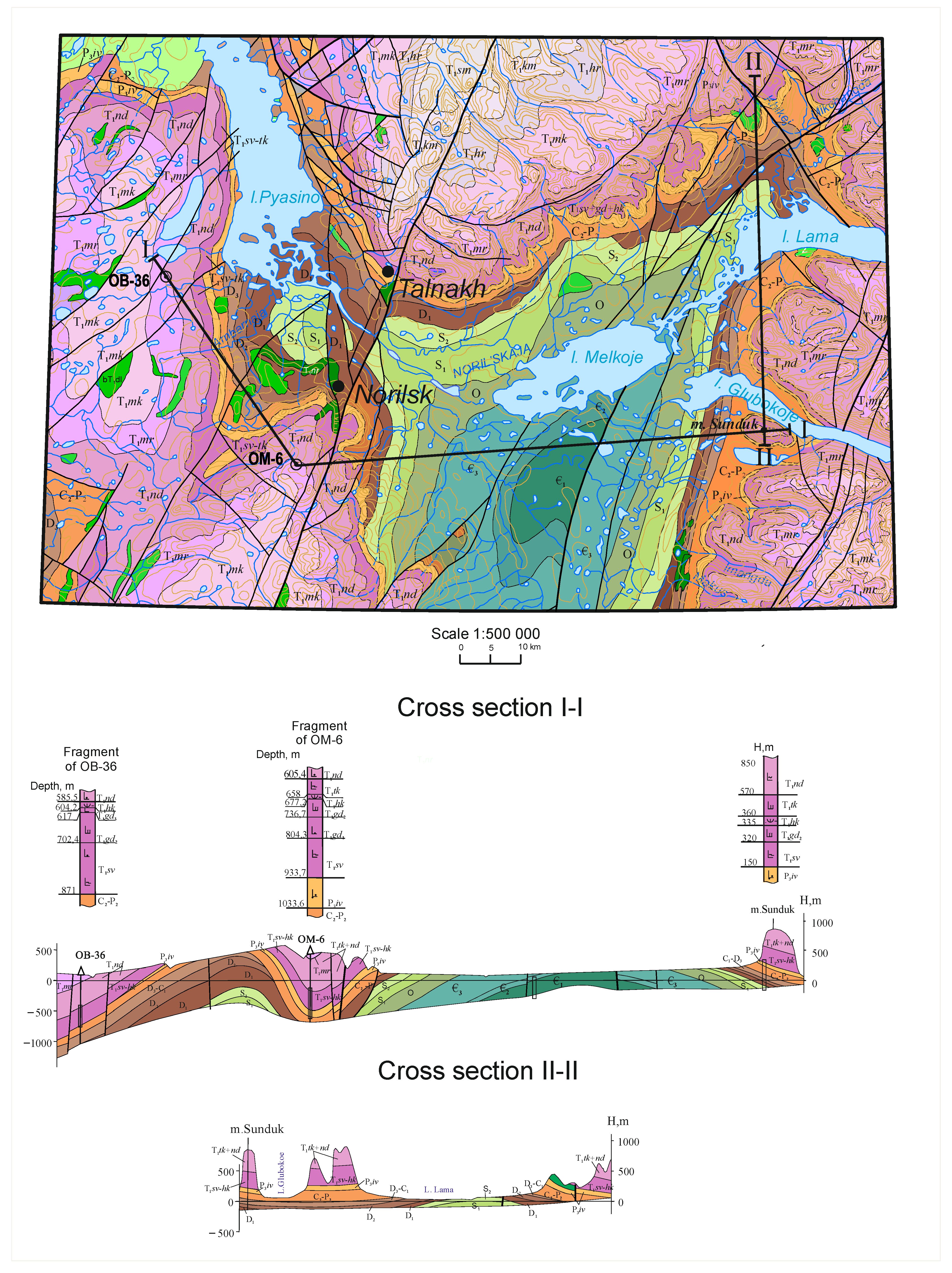
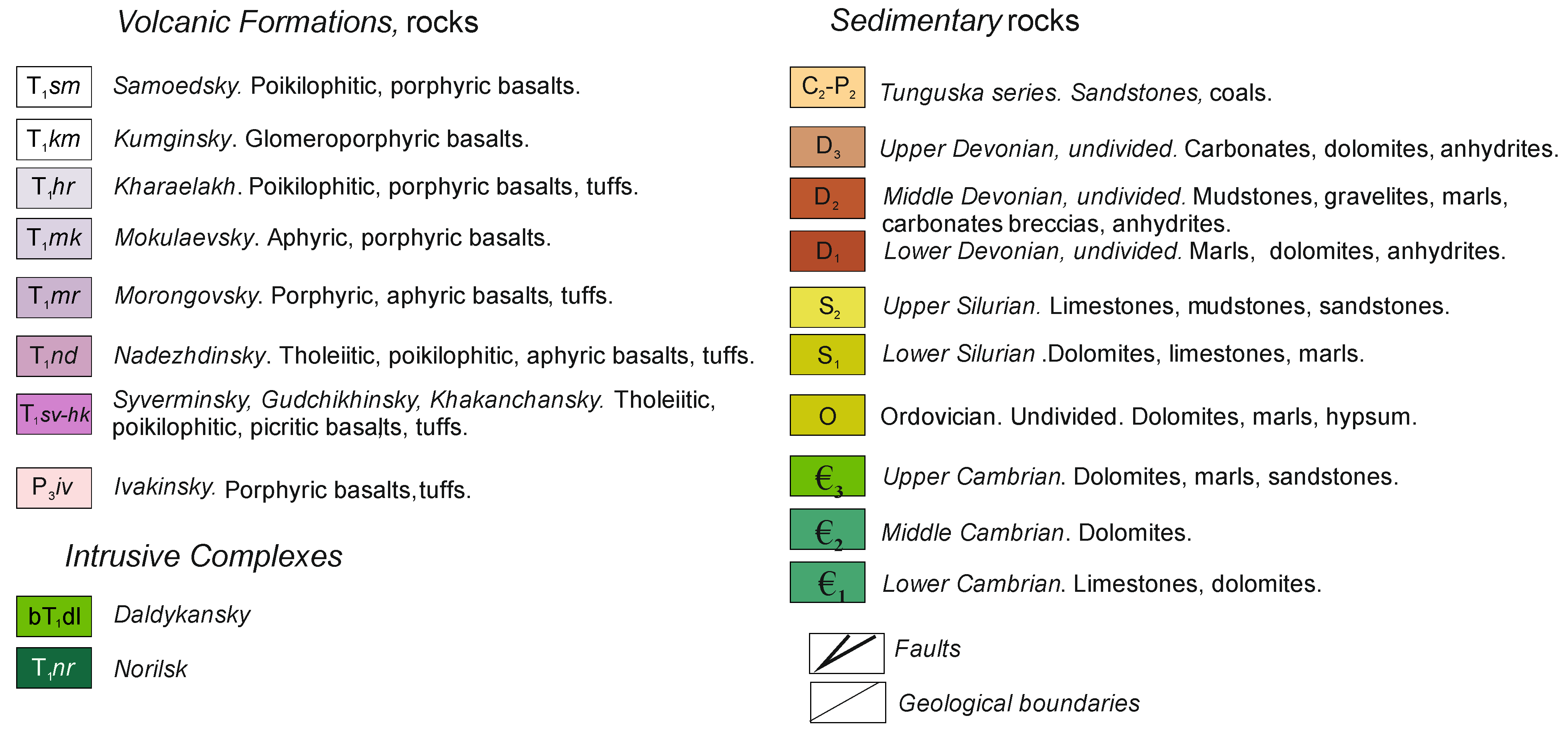

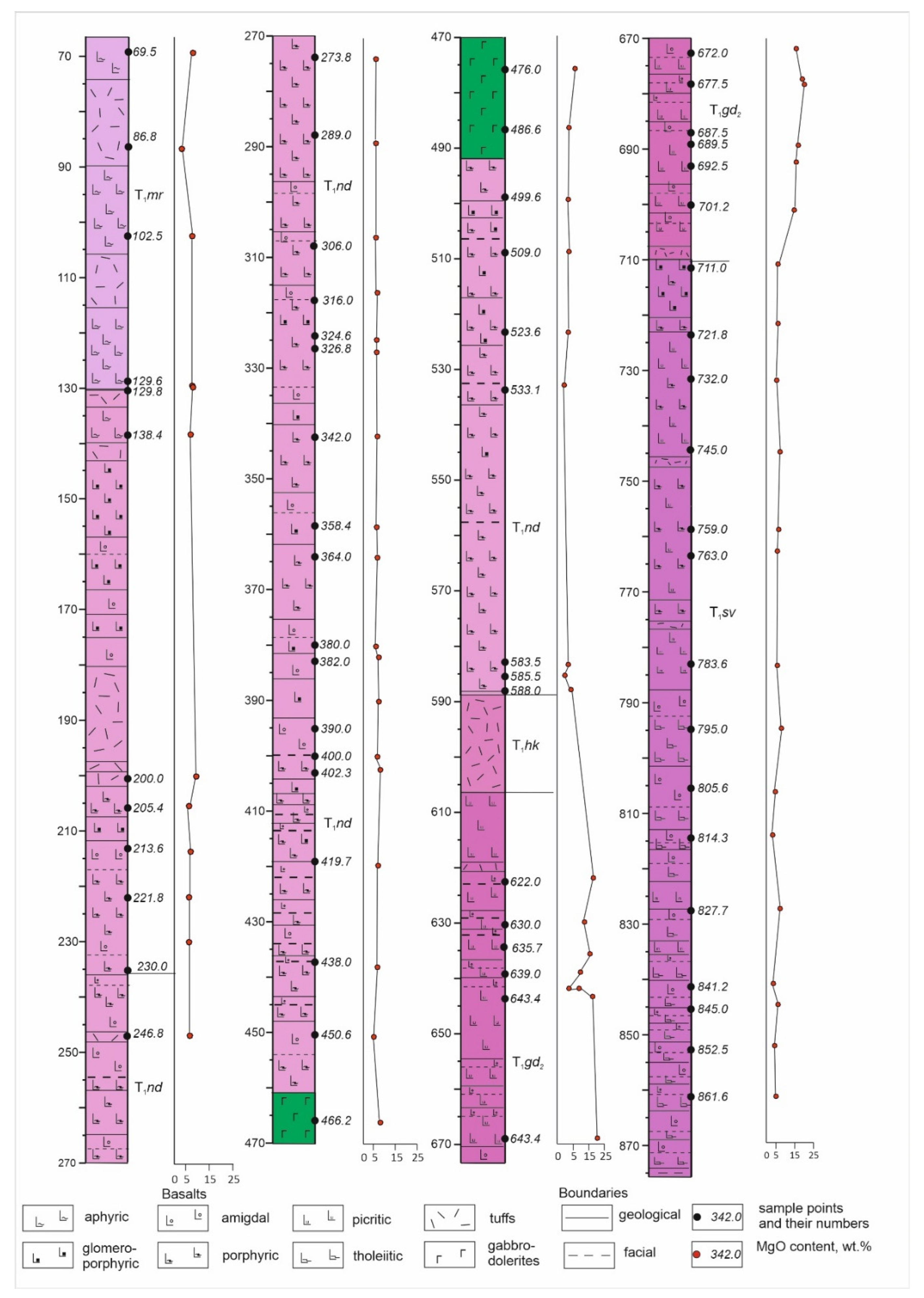

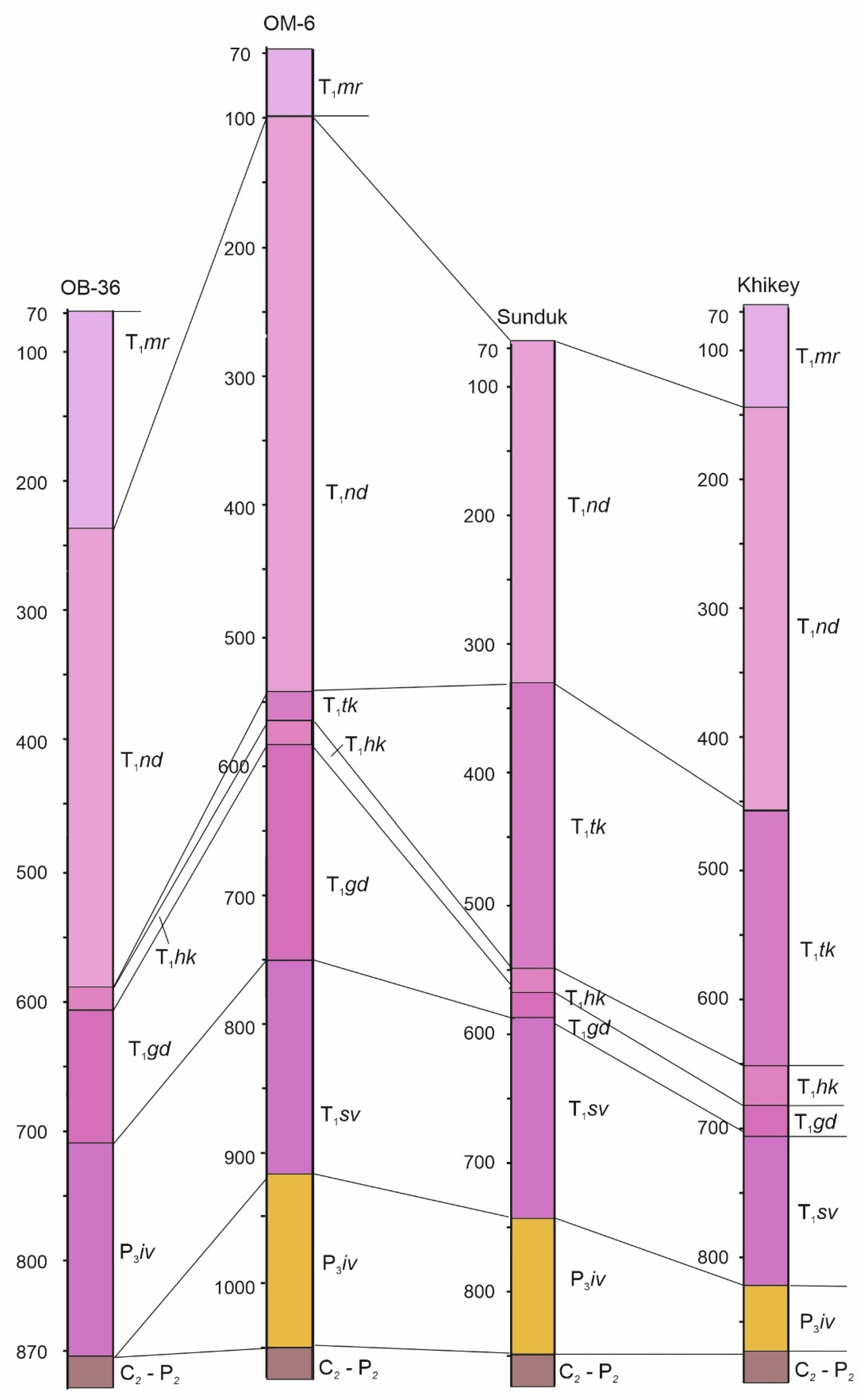
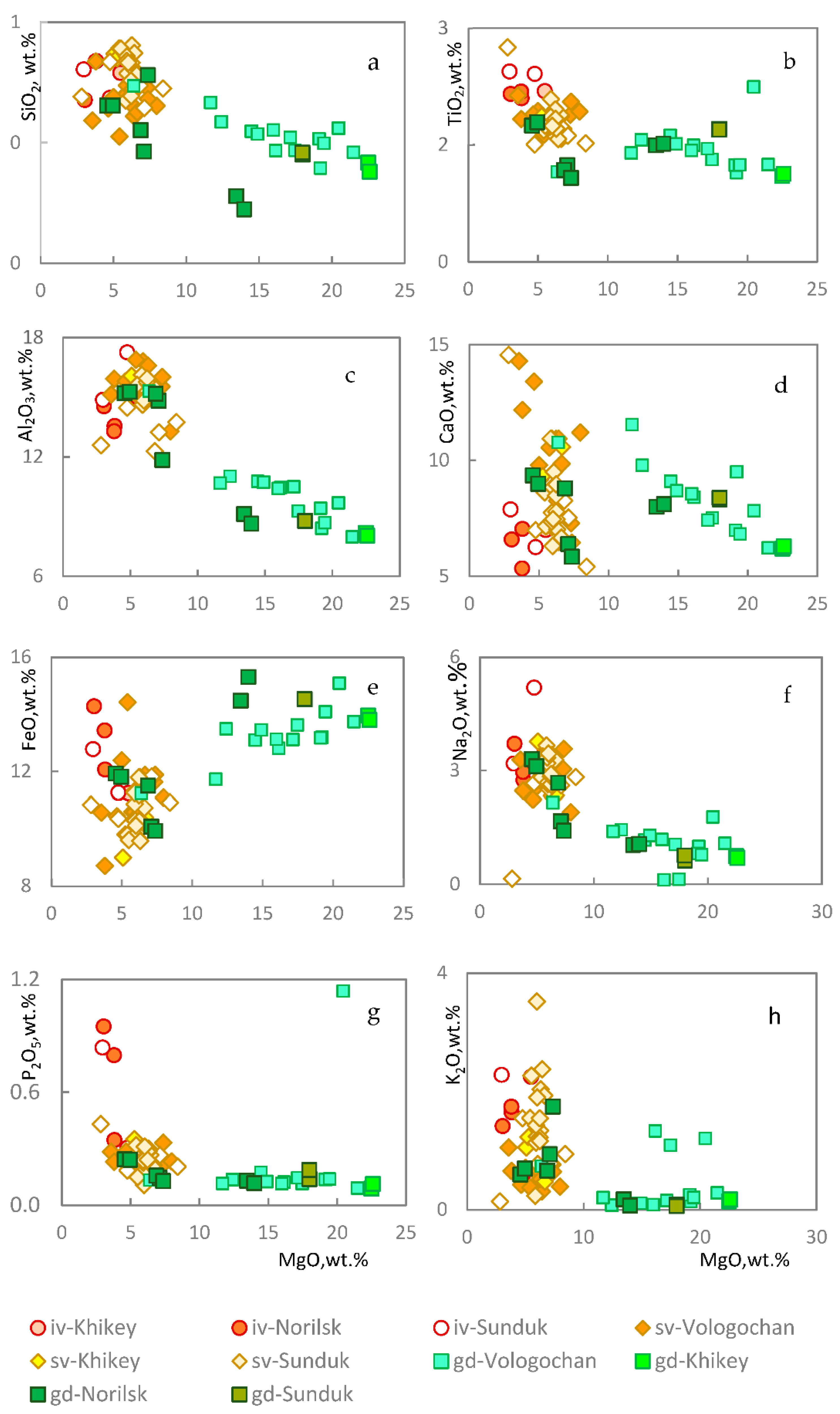

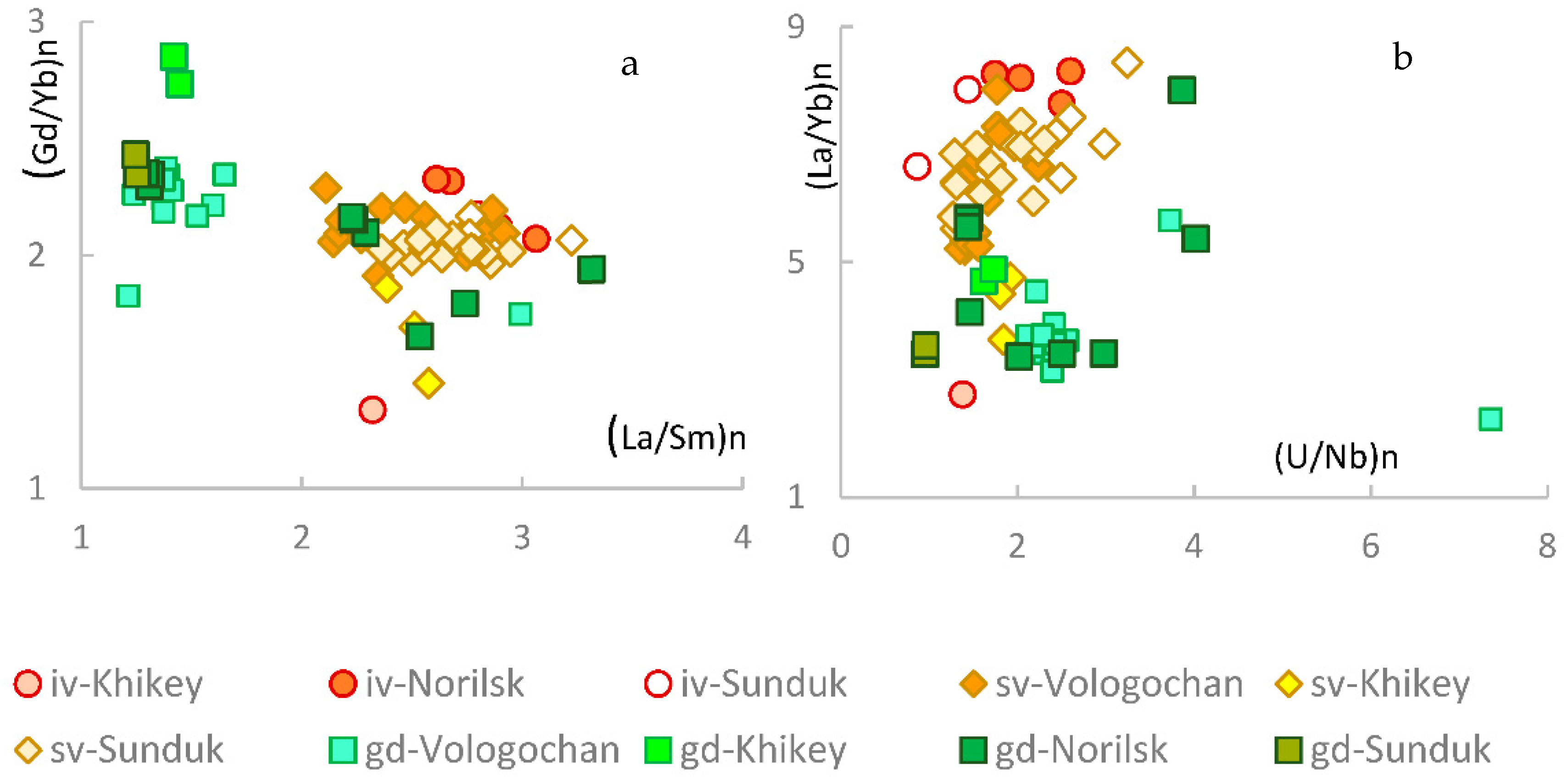
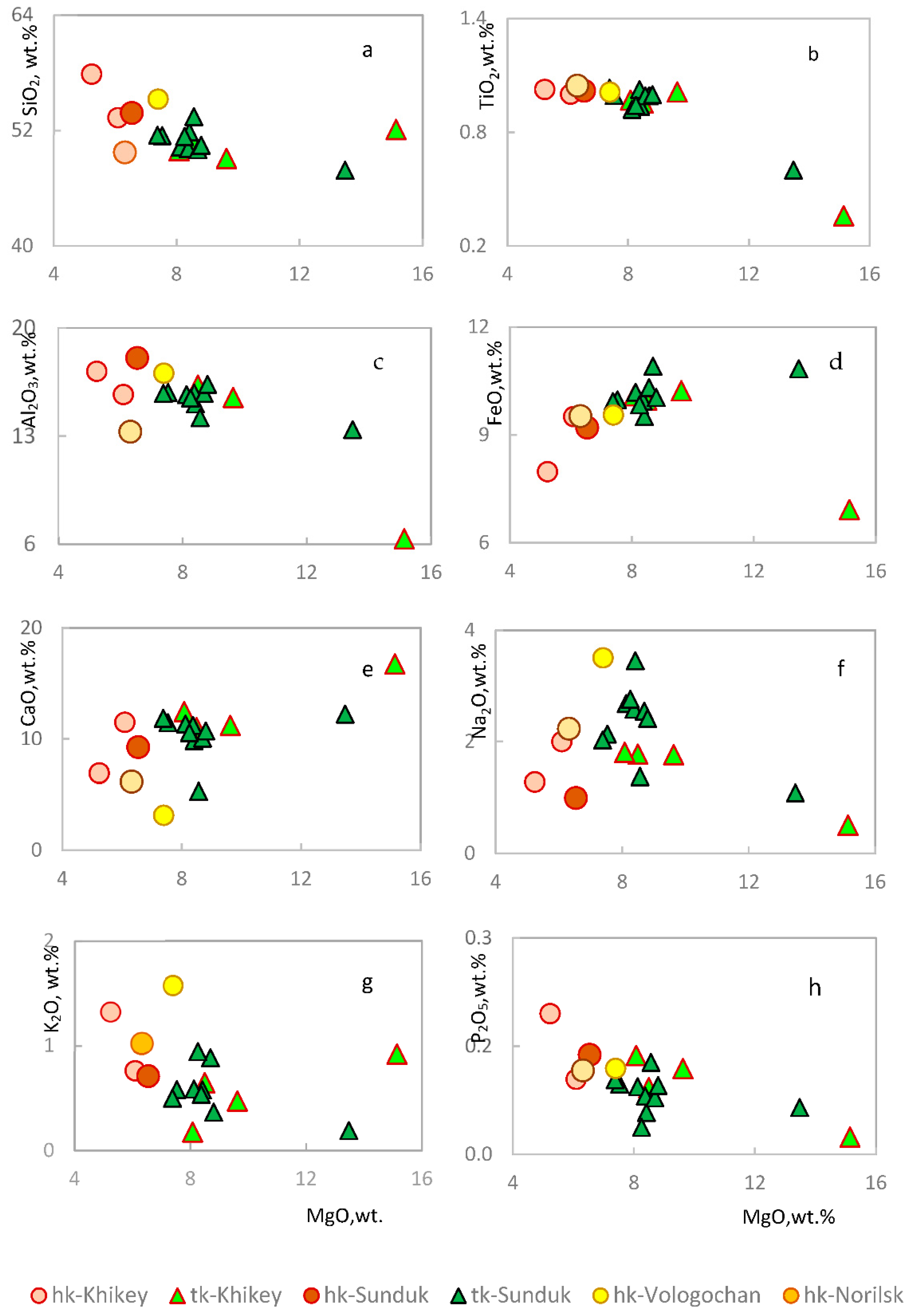
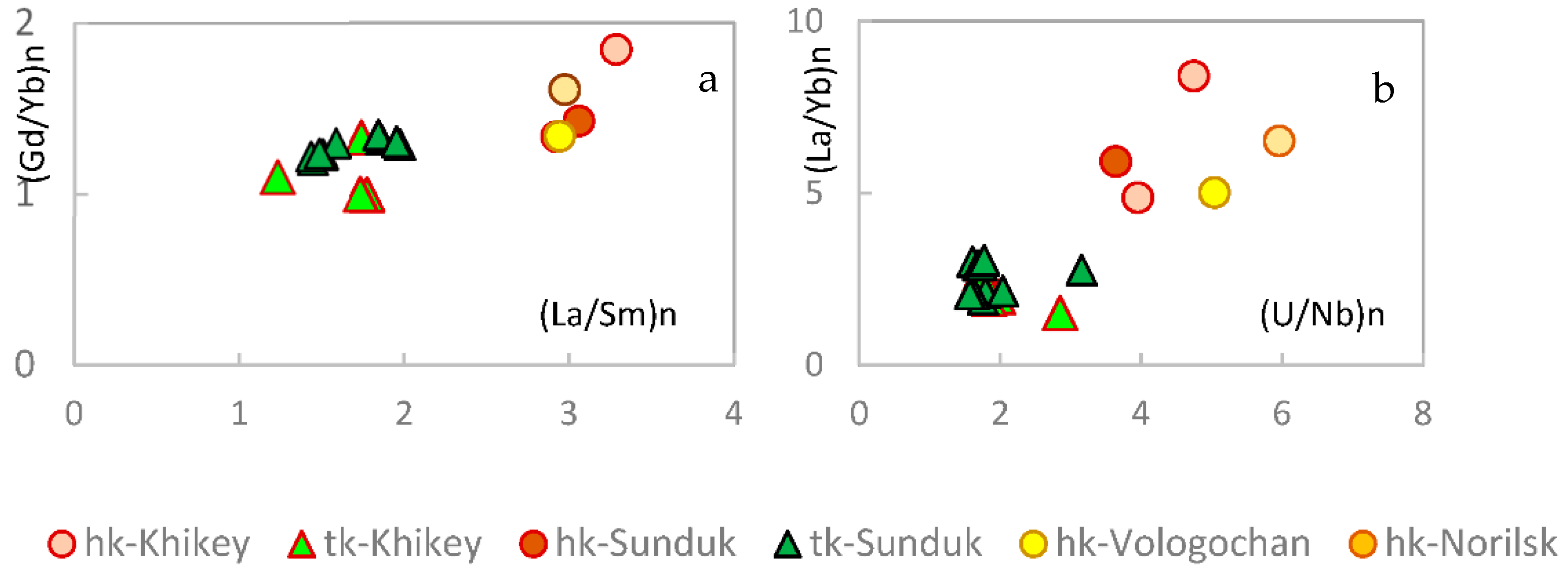

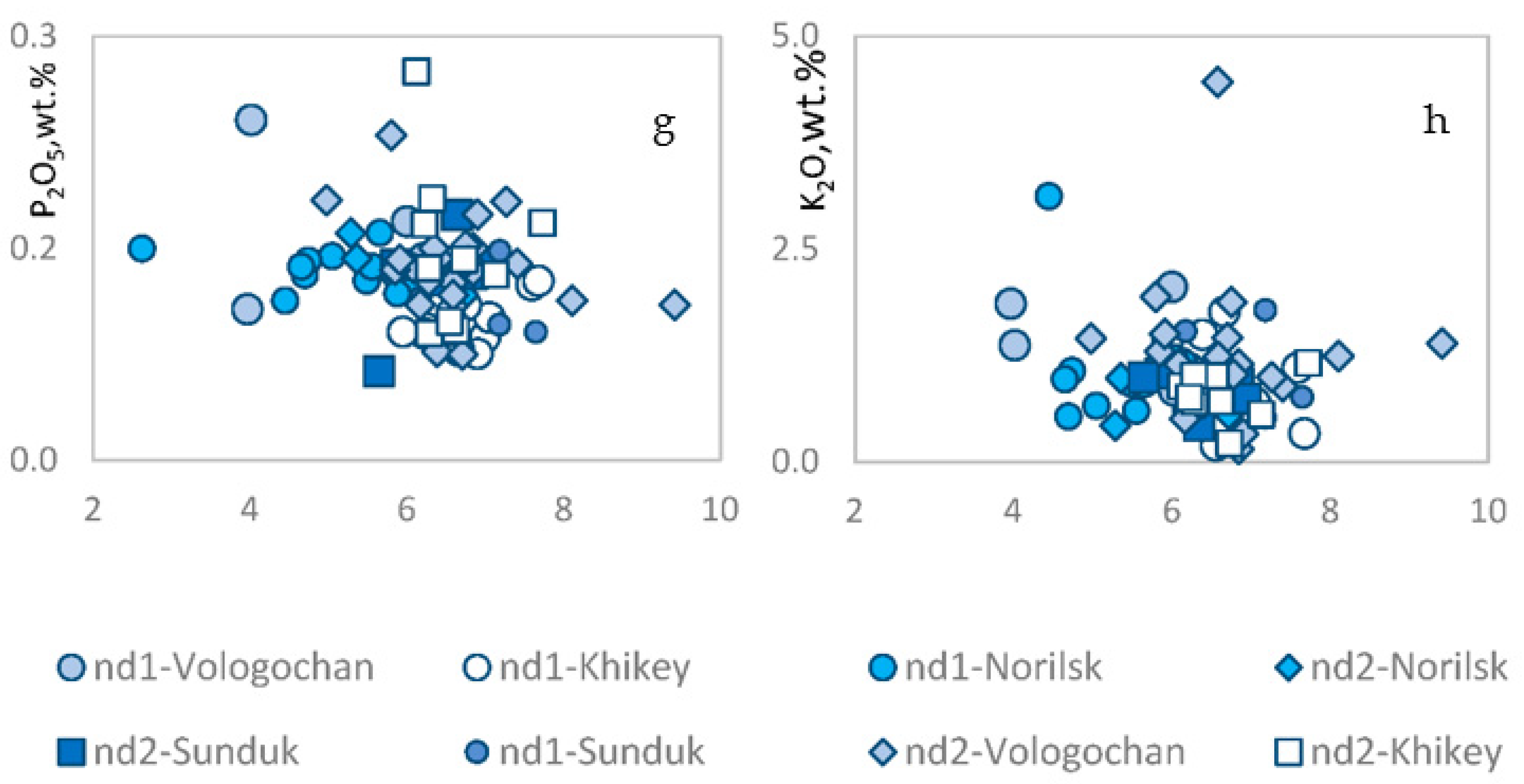
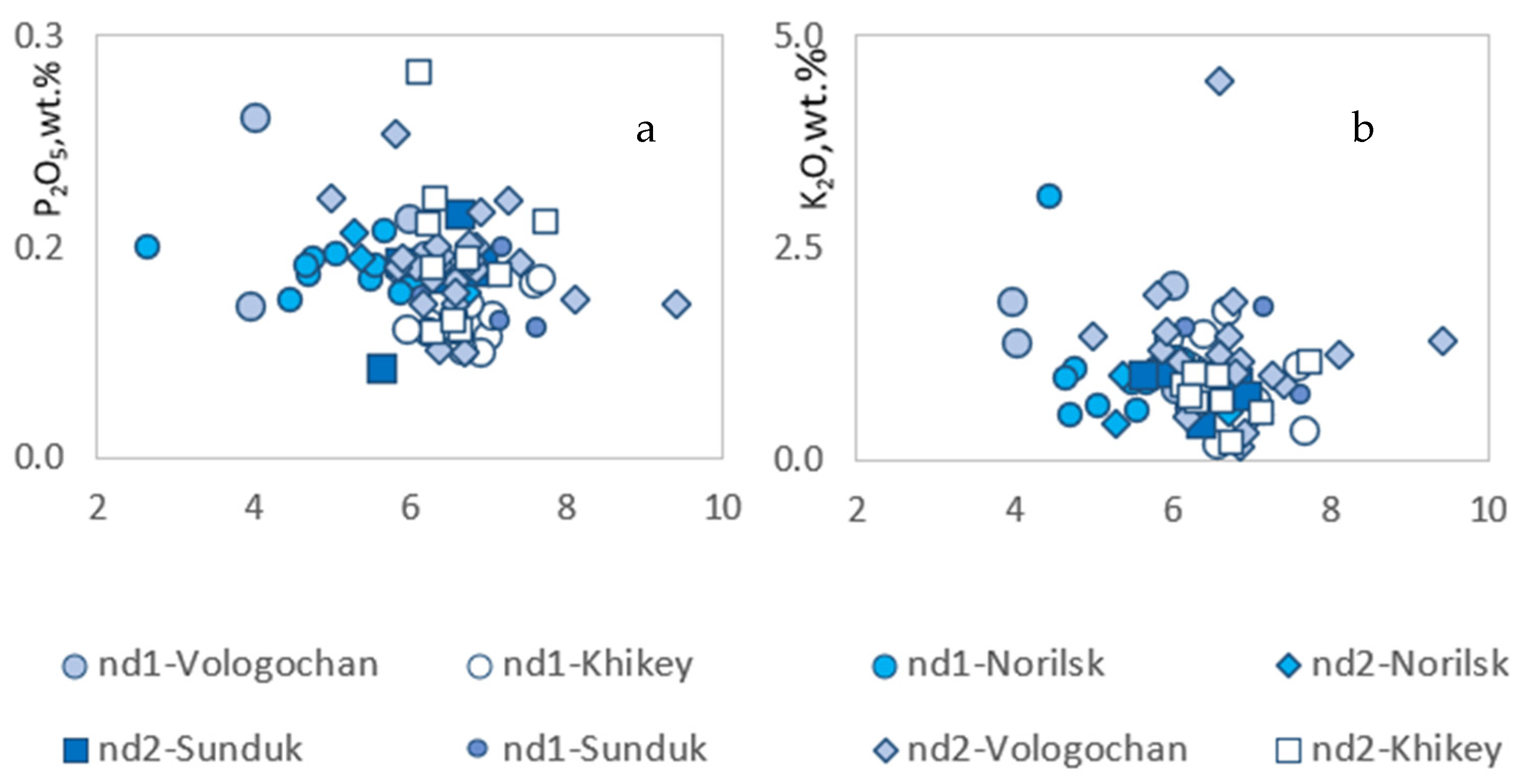
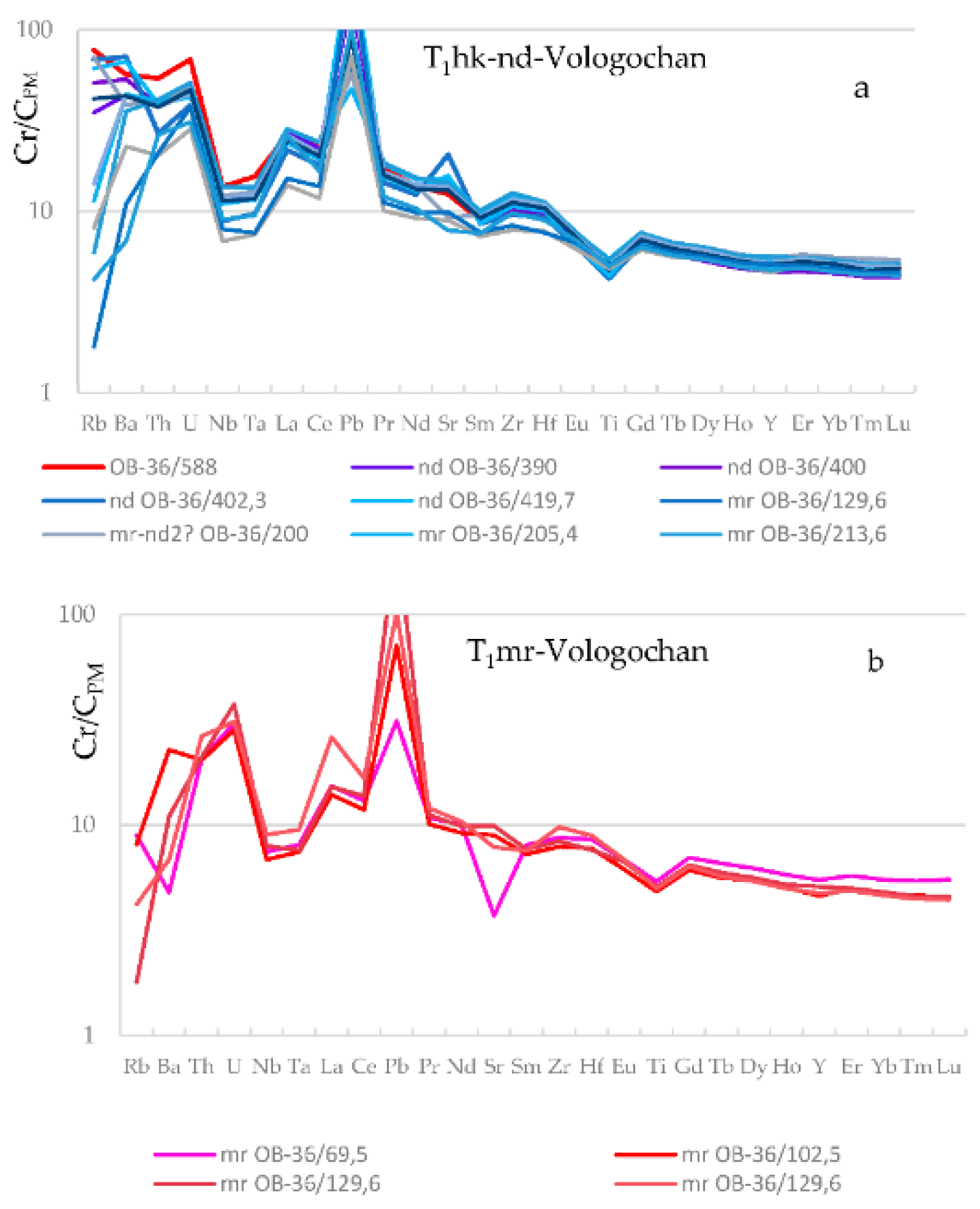
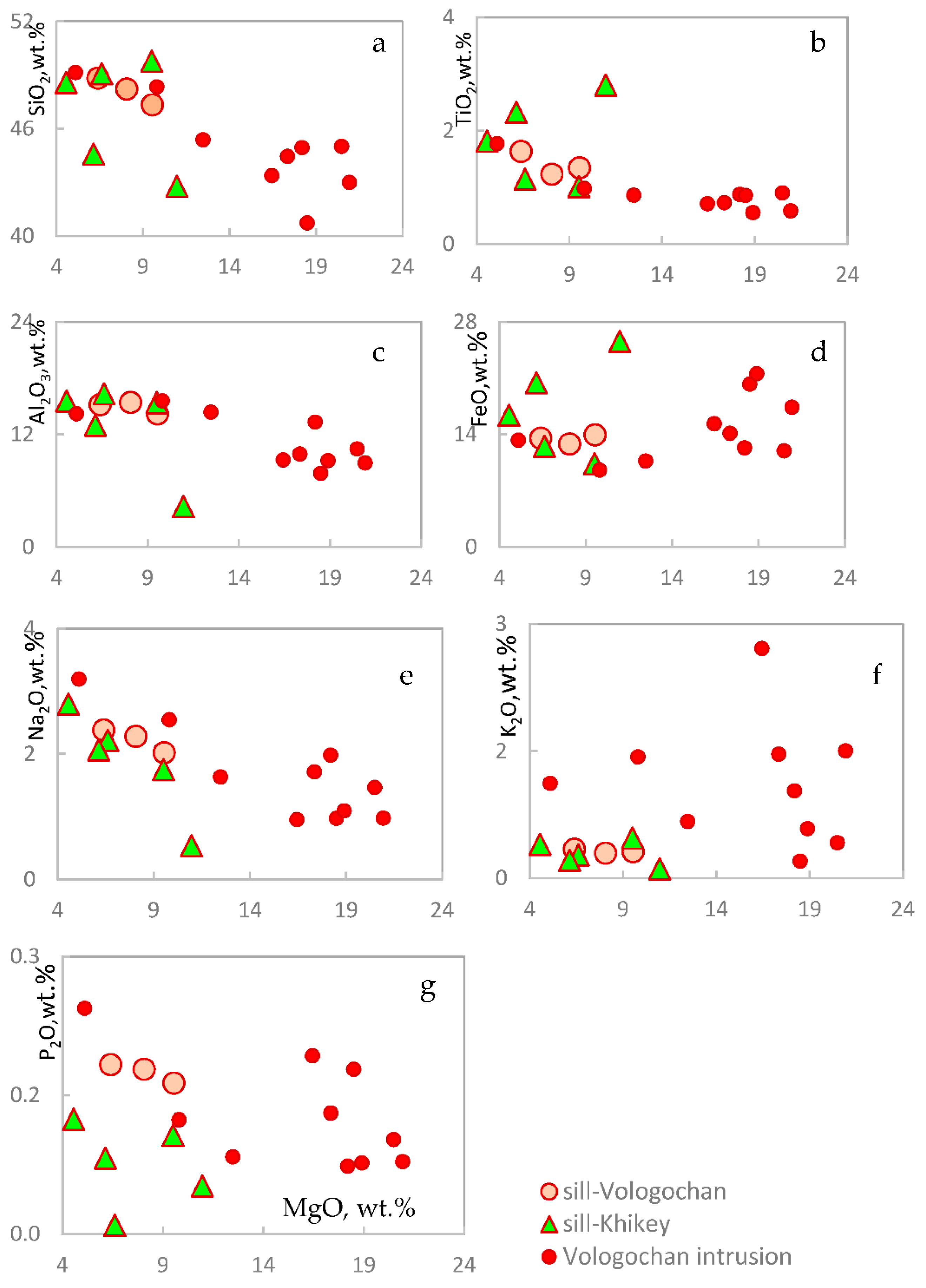
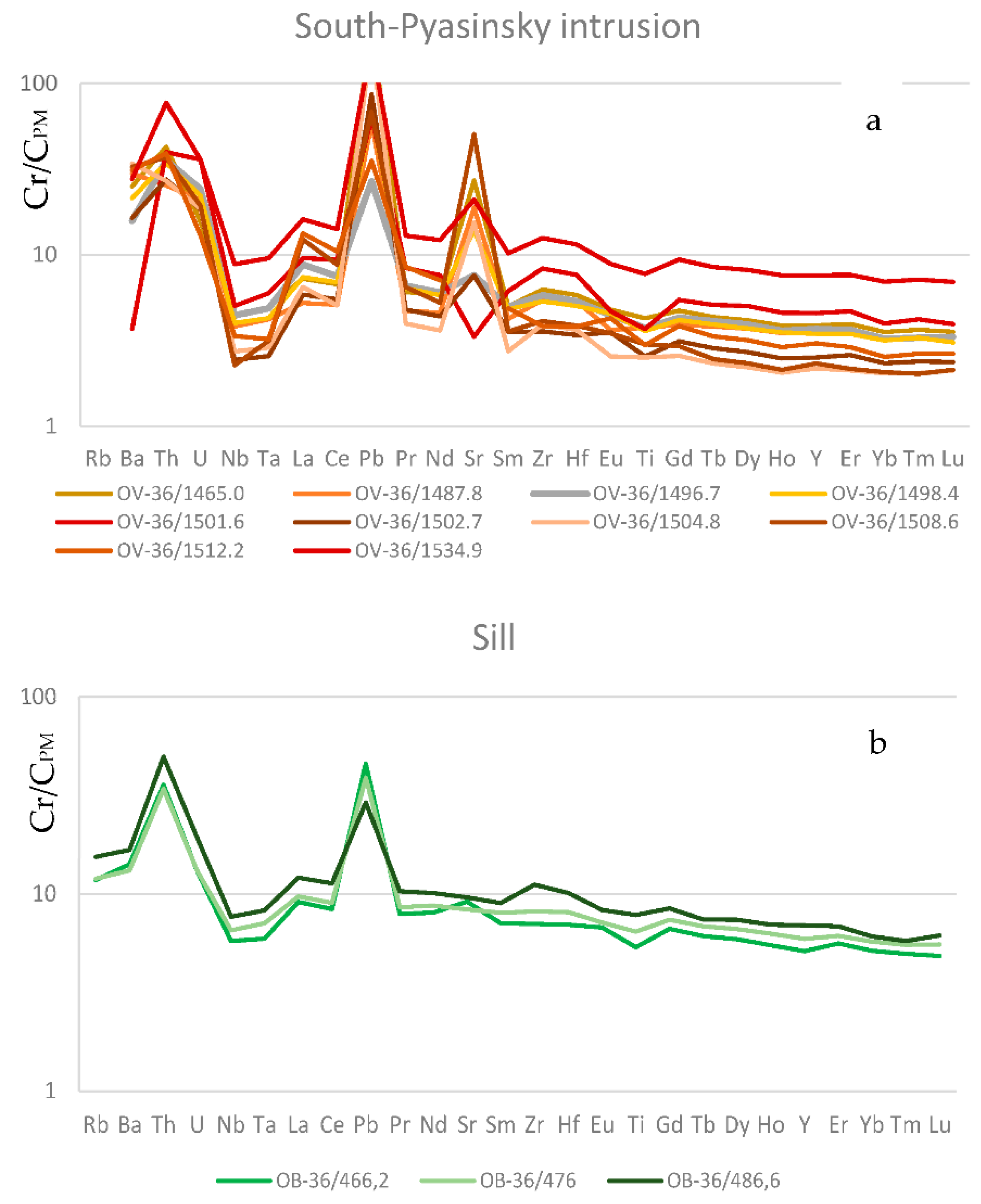


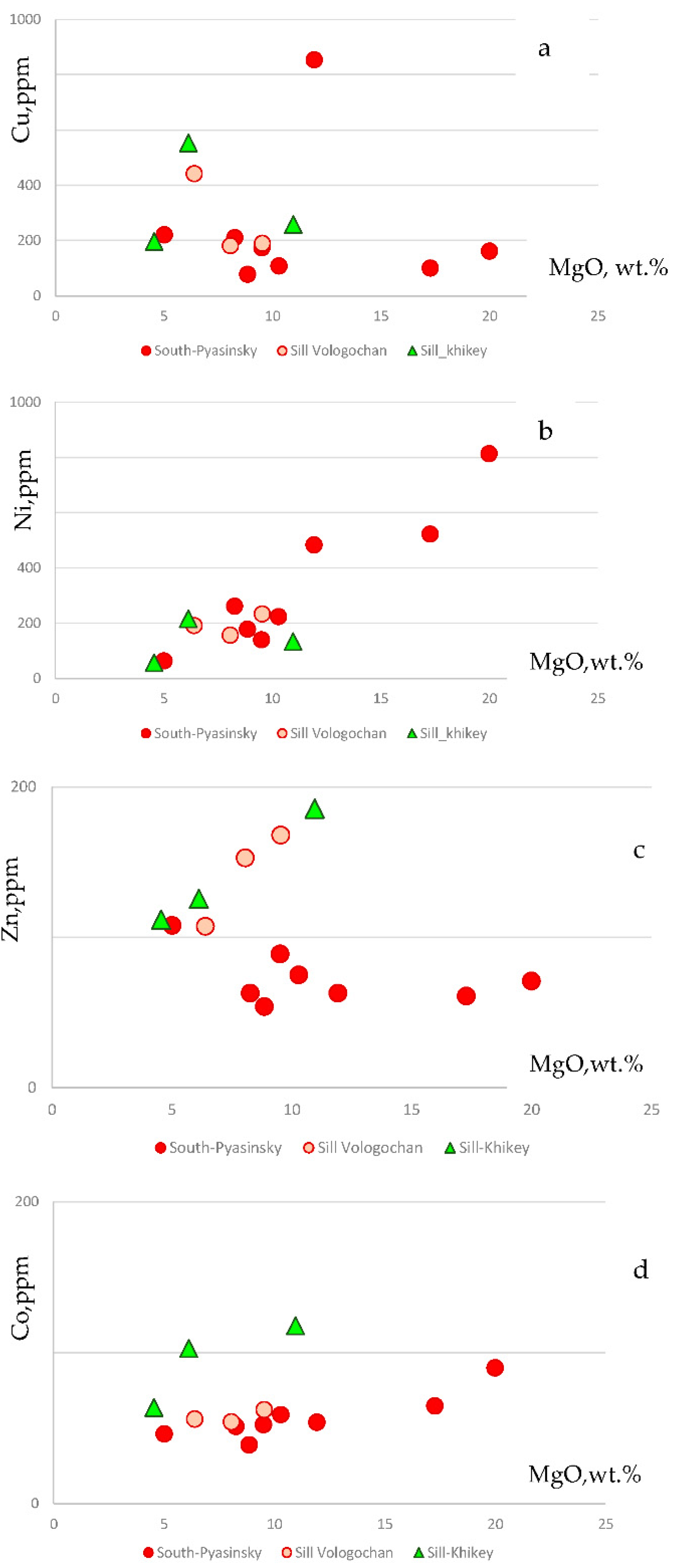
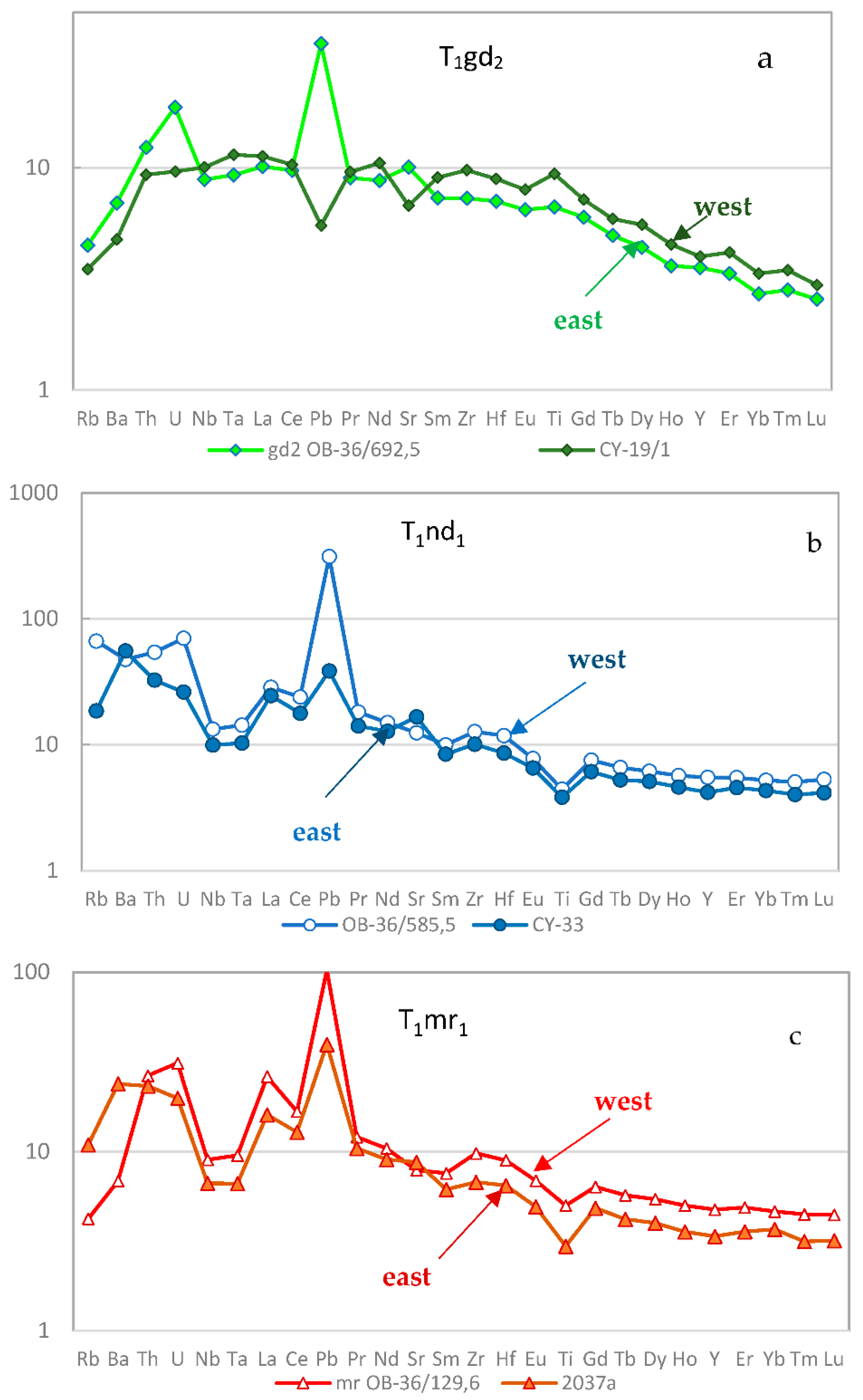
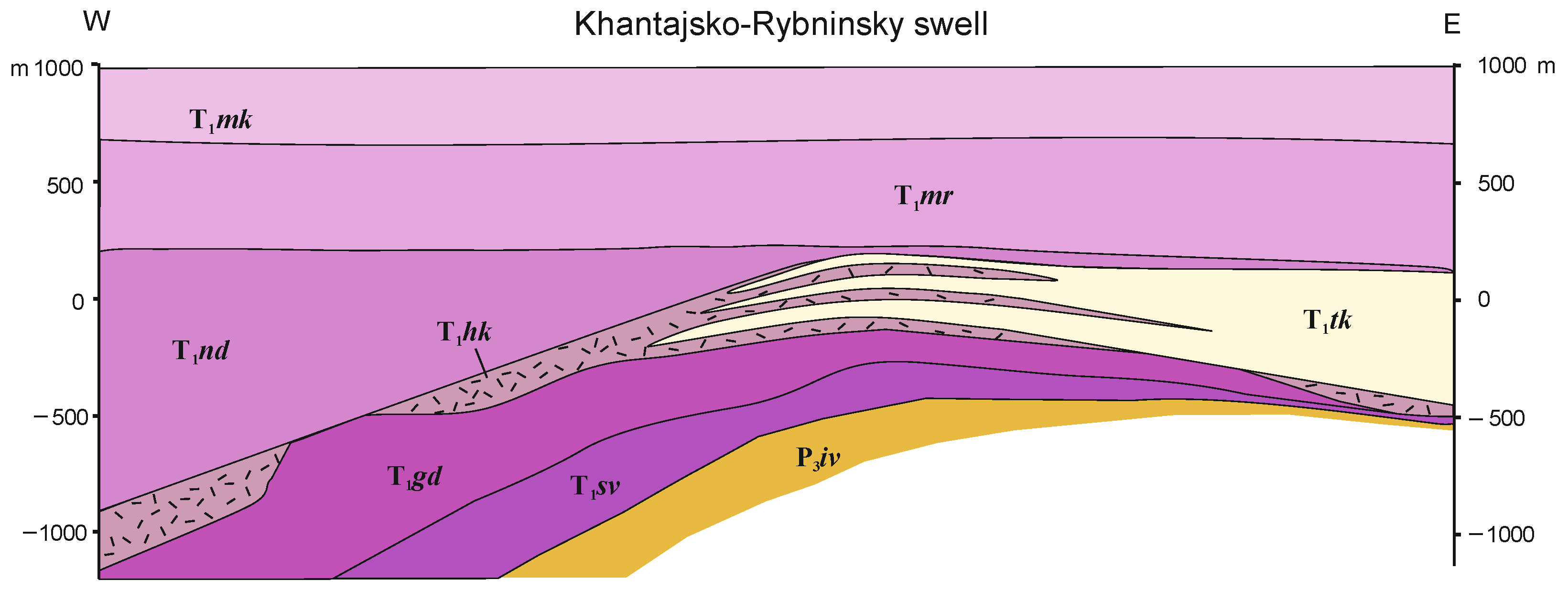
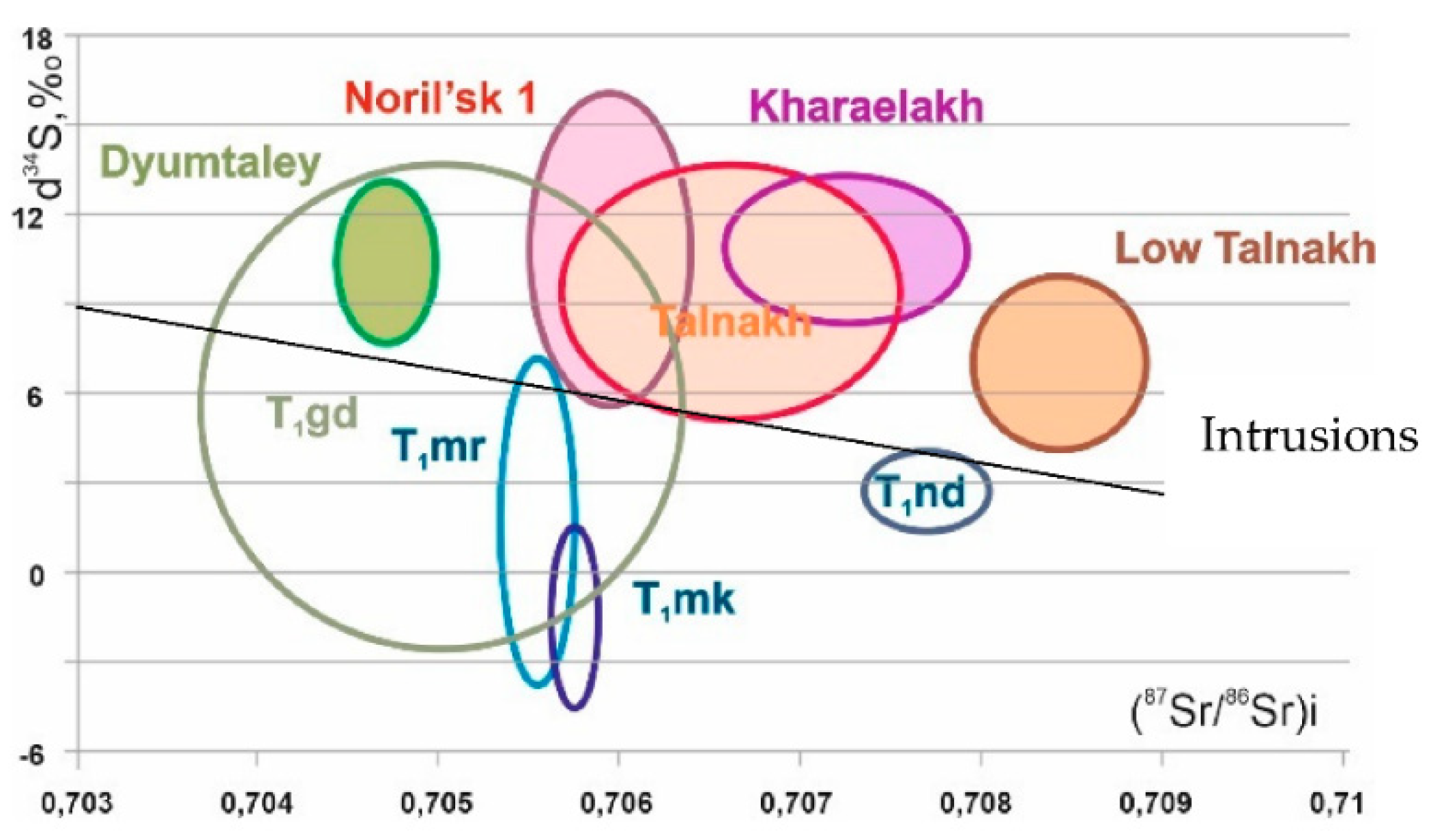
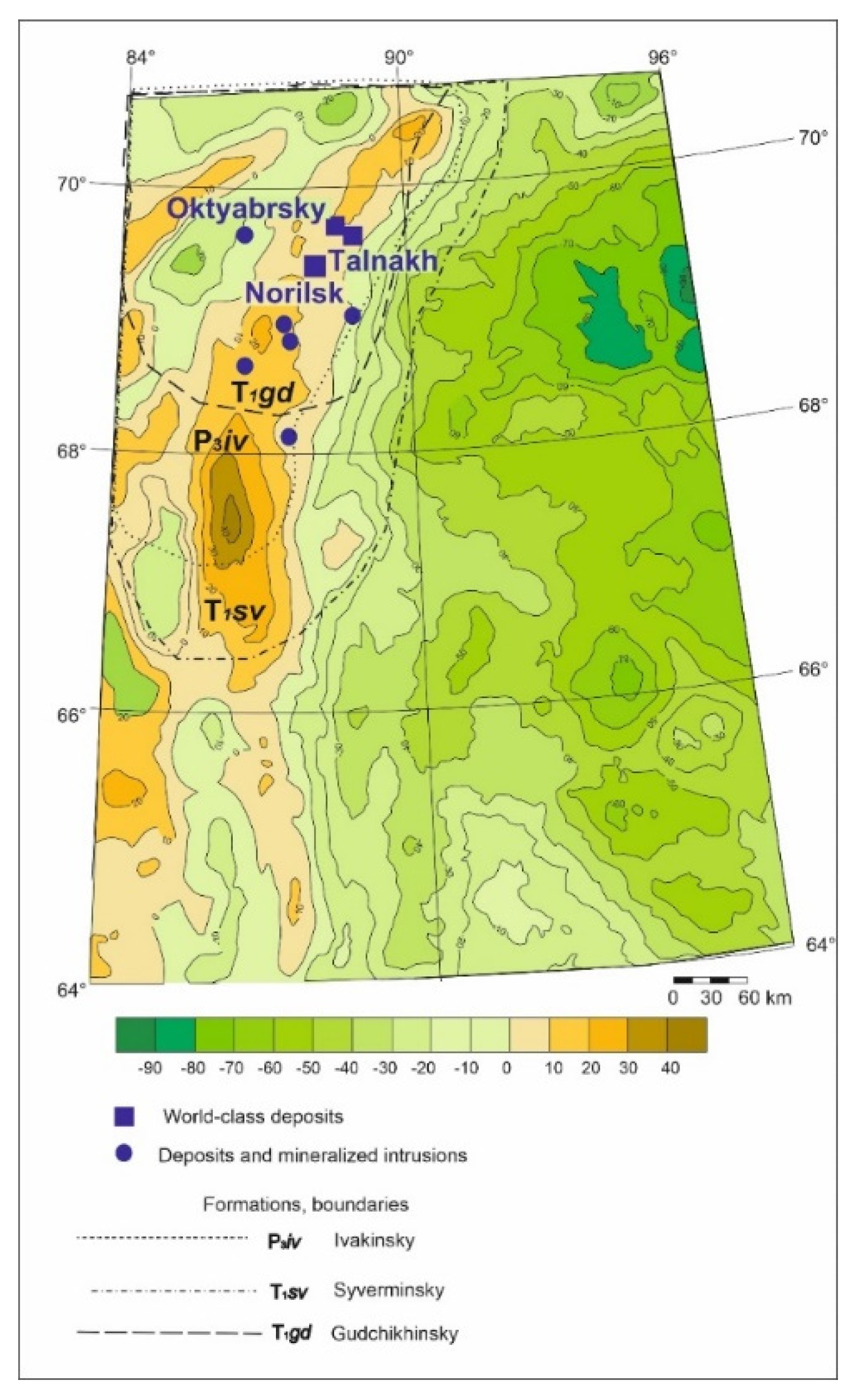

| Formation | Rock | Structure | Texture |
|---|---|---|---|
| Morongovsky | Tholeiitic basalt | Aphyric, porphyritic | Ophitic, |
| Nadezhdinsky | Tholeiitic basalt, Picritic basalt, Olivine basalt | Porphyritic, Glomeroporphyritic | Tholeiitic, ophitic, poikiloophitic |
| Tuklonsky | Tholeiitic basalt, Picritic basalt, Picrite | Aphyric porphyritic | Tholeiitic, Poikiloophitic |
| Khakanchansky | Tuff | Vitrophyric | |
| Gudchikhinsky | Picrite, picritic basalt, Olivine basalt | Porphyritic | Poikiloophitic |
| Syverminsky | Tholeiitic basalt | Aphyric | Tholeiitic, Poikiloophitic |
| Ivakinsky | Trachybasalt, Basaltic andesite | Porphyritic | Ophitic |
| Component | No | 1 | 2 | 3 | 4 | 5 | 6 | 7 | 8 | 9 |
|---|---|---|---|---|---|---|---|---|---|---|
| Depth, m | 69.5 | 221.8 | 273.8 | 289 | 583.5 | 588 | 669 | 745 | 845 | |
| Formation | mr | mr | nd 3 | nd 2 | nd1 | hk | gd 2 | sv | sv | |
| SiO2 | 49.43 | 50.87 | 52.16 | 53.08 | 53.04 | 55.23 | 47.36 | 51.65 | 51.58 | |
| TiO2 | 1.15 | 1.11 | 1.06 | 1.05 | 0.99 | 1.01 | 1.25 | 1.89 | 1.94 | |
| Al2O3 | 16.38 | 16.27 | 15.08 | 15.31 | 15.49 | 17.07 | 7.98 | 15.54 | 16.60 | |
| Fe2O3 | 12.01 | 10.57 | 10.70 | 10.50 | 9.82 | 9.55 | 13.74 | 11.63 | 11.80 | |
| MnO | 0.22 | 0.22 | 0.15 | 0.20 | 0.19 | 0.23 | 0.20 | 0.19 | 0.25 | |
| MgO | 7.96 | 6.37 | 6.09 | 5.85 | 5.86 | 7.40 | 21.48 | 7.30 | 6.30 | |
| CaO | 10.18 | 11.18 | 10.04 | 9.81 | 10.90 | 3.13 | 6.22 | 7.29 | 8.26 | |
| Na2O | 1.93 | 2.11 | 2.12 | 2.24 | 2.13 | 3.50 | 1.08 | 3.04 | 2.33 | |
| K2O | 0.25 | 0.69 | 1.15 | 1.30 | 1.12 | 1.57 | 0.28 | 0.77 | 0.52 | |
| P2O5 | 0.17 | 0.14 | 0.14 | 0.14 | 0.13 | 0.12 | 0.09 | 0.21 | 0.30 | |
| Sc | 39.2 | 32.0 | 33.15 | 33.40 | 34.99 | 31.65 | 21.69 | 30.79 | 28.97 | |
| V | 306 | 239 | 260 | 246 | 245 | 221 | 247 | 245 | 231 | |
| Co | 51.5 | 43.3 | 40.8 | 40.2 | 36.1 | 40.2 | 107 | 45.5 | 38.7 | |
| Ni | 128 | 64.0 | 33.4 | 38.5 | 29.2 | 94.9 | 1261 | 62.1 | 45.3 | |
| Cu | 136 | 107 | 115 | 92.9 | 36.5 | 51.4 | 108 | 25.6 | 31.8 | |
| Zn | 101 | 145 | 129 | 122 | 120 | 136 | 126 | 123 | 132 | |
| Rb | 5.67 | 9.01 | 26.8 | 39.8 | 39.2 | 49.2 | 9.73 | 18.2 | 3.51 | |
| Sr | 78.7 | 287 | 257 | 243 | 271 | 263 | 175 | 407 | 436 | |
| Y | 25.0 | 23.71 | 24.7 | 26.1 | 26.0 | 23.9 | 12.7 | 24.0 | 27.7 | |
| Zr | 98.0 | 131 | 141 | 146 | 142 | 116 | 70.6 | 151 | 212 | |
| Nb | 5.33 | 8.38 | 9.48 | 9.05 | 9.42 | 9.76 | 5.39 | 11.07 | 14.3 | |
| La | 10.5 | 18.1 | 20.9 | 21.1 | 22.2 | 18.1 | 5.42 | 16.8 | 27.2 | |
| Ce | 23.2 | 37.2 | 43.1 | 42.7 | 44.3 | 40.9 | 14.1 | 37.9 | 55.4 | |
| Pr | 2.99 | 4.55 | 5.15 | 5.23 | 5.44 | 4.73 | 1.98 | 4.72 | 6.87 | |
| Nd | 13.6 | 19.0 | 21.1 | 21.8 | 22.4 | 18.8 | 9.43 | 20.7 | 28.4 | |
| Sm | 3.57 | 4.15 | 4.42 | 4.73 | 4.82 | 3.98 | 2.54 | 4.80 | 6.03 | |
| Eu | 1.15 | 1.22 | 1.25 | 1.27 | 1.23 | 1.11 | 0.89 | 1.73 | 2.05 | |
| Gd | 4.17 | 4.35 | 4.56 | 4.92 | 4.79 | 4.19 | 2.79 | 5.04 | 6.14 | |
| Tb | 0.71 | 0.69 | 0.72 | 0.78 | 0.74 | 0.67 | 0.43 | 0.80 | 0.93 | |
| Dy | 4.59 | 4.49 | 4.66 | 4.95 | 4.75 | 4.47 | 2.56 | 4.81 | 5.57 | |
| Ho | 0.95 | 0.90 | 0.93 | 1.01 | 0.94 | 0.88 | 0.50 | 0.91 | 1.09 | |
| Er | 2.76 | 2.65 | 2.65 | 2.95 | 2.74 | 2.58 | 1.28 | 2.48 | 2.99 | |
| Tm | 2.71 | 2.56 | 2.73 | 2.78 | 2.65 | 2.59 | 1.09 | 2.21 | 2.73 | |
| Yb | 0.40 | 0.37 | 0.38 | 0.41 | 0.38 | 0.37 | 0.17 | 0.34 | 0.41 | |
| Lu | 0.41 | 0.37 | 0.39 | 0.41 | 0.40 | 0.36 | 0.15 | 0.31 | 0.39 | |
| Hf | 2.64 | 3.36 | 3.65 | 3.96 | 3.65 | 3.09 | 1.86 | 3.71 | 5.08 | |
| Ta | 0.33 | 0.51 | 0.58 | 0.56 | 0.60 | 0.64 | 0.34 | 0.61 | 0.81 | |
| Pb | 2.22 | 12.32 | 6.97 | 7.46 | 7.52 | 4.85 | 3.70 | 4.47 | 15.45 | |
| U | 0.64 | 0.94 | 1.07 | 1.09 | 1.12 | 1.45 | 0.35 | 0.49 | 0.76 | |
| Component | Number | ||||||||
|---|---|---|---|---|---|---|---|---|---|
| 1 | 2 | 3 | 4 | 5 | 6 | 7 | 8 | 9 | |
| Sample Number | |||||||||
| 2009 | 2013 | 2017b | 2018-1 | 2019 | 2025/1 | 2026/4 | 2029 | 2030/2 | |
| Formation | |||||||||
| iv | sv | gd 2 | hk | tk | nd | nd | mr | mr | |
| SiO2 | 52.64 | 53.90 | 46.67 | 57.23 | 50.96 | 52.00 | 50.41 | 49.20 | 50.67 |
| TiO2 | 2.19 | 1.83 | 1.10 | 0.98 | 0.96 | 1.08 | 1.13 | 0.99 | 1.08 |
| Al2O3 | 15.02 | 16.08 | 8.18 | 16.87 | 16.30 | 16.12 | 15.15 | 15.23 | 15.81 |
| FeO | 11.25 | 9.00 | 13.95 | 6.62 | 9.97 | 10.83 | 11.21 | 10.87 | 11.22 |
| MnO | 0.17 | 0.17 | 0.21 | 0.11 | 0.20 | 0.17 | 0.24 | 0.17 | 0.22 |
| MgO | 5.48 | 5.08 | 22.5 | 4.35 | 8.49 | 6.29 | 7.73 | 9.32 | 7.56 |
| CaO | 7.00 | 9.19 | 6.19 | 9.88 | 11.00 | 10.62 | 8.95 | 10.23 | 11.38 |
| Na2O | 3.37 | 3.77 | 0.74 | 1.48 | 1.77 | 2.03 | 2.98 | 1.63 | 1.99 |
| K2O | 2.25 | 1.06 | 0.14 | 1.50 | 0.65 | 0.71 | 1.16 | 2.15 | 0.39 |
| P2O5 | 0.19 | 0.25 | 0.09 | 0.17 | 0.09 | 0.09 | 0.17 | 0.15 | 0.11 |
| Total | 99.2 | 100.3 | 99.8 | 99.2 | 100.4 | 99.9 | 99.7 | 99.9 | 100.4 |
| Rb | 76.26 | 25.20 | 8.23 | 56.19 | 12.08 | 11.96 | 33.59 | 122 | 10.84 |
| Ba | 1110 | 385 | 35.6 | 322 | 411 | 292 | 357 | 155 | 121 |
| Th | 2.40 | 3.11 | 0.83 | 5.83 | 0.79 | 3.45 | 2.12 | 1.68 | 1.32 |
| U | 0.55 | 0.77 | 0.22 | 2.09 | 0.19 | 0.87 | 0.70 | 0.44 | 0.47 |
| Nb | 13.65 | 14.14 | 4.65 | 11.93 | 3.21 | 8.56 | 5.95 | 4.71 | 4.33 |
| Ta | 0.87 | 0.87 | 0.29 | 0.78 | 0.21 | 0.54 | 0.37 | 0.30 | 0.27 |
| La | 21.5 | 24.8 | 5.75 | 31.6 | 6.69 | 16.7 | 11.9 | 11.6 | 7.92 |
| Ce | 47.7 | 49.2 | 13.9 | 59.1 | 14.4 | 35.0 | 24.9 | 23.0 | 17.8 |
| Pb | 4.87 | 5.03 | 1.39 | 11.33 | 1.98 | 3.89 | 2.63 | 1.57 | 2.77 |
| Pr | 6.06 | 6.36 | 2.00 | 6.71 | 1.94 | 4.37 | 3.22 | 2.96 | 2.39 |
| Nd | 26.6 | 28.0 | 9.48 | 26.8 | 9.01 | 18.3 | 14.3 | 13.3 | 11.3 |
| Sr | 692 | 239 | 127 | 129 | 322 | 263 | 304 | 161 | 190 |
| Sm | 6.00 | 6.22 | 2.57 | 5.44 | 2.44 | 4.22 | 3.50 | 3.19 | 3.04 |
| Zr | 209 | 209 | 70.4 | 146 | 66.5 | 143 | 107 | 90.8 | 88.4 |
| Hf | 4.87 | 5.04 | 1.82 | 3.54 | 1.78 | 3.58 | 2.83 | 2.40 | 2.33 |
| Eu | 1.95 | 1.97 | 0.86 | 1.51 | 1.00 | 1.21 | 1.10 | 1.06 | 1.04 |
| Ti | 11898 | 10710 | 6590 | 6389 | 5795 | 6507 | 6894 | 6174 | 6618 |
| Gd | 6.26 | 6.20 | 2.85 | 5.20 | 2.92 | 4.63 | 4.15 | 3.78 | 3.76 |
| Tb | 0.93 | 0.98 | 0.46 | 0.77 | 0.50 | 0.72 | 0.70 | 0.62 | 0.63 |
| Dy | 5.76 | 5.94 | 2.71 | 4.94 | 3.35 | 4.70 | 4.56 | 4.13 | 4.31 |
| Ho | 1.11 | 1.12 | 0.52 | 0.96 | 0.67 | 0.97 | 0.94 | 0.85 | 0.89 |
| Y | 29.36 | 29.98 | 13.77 | 24.90 | 18.03 | 25.86 | 24.91 | 23.07 | 23.56 |
| Er | 3.06 | 3.16 | 1.42 | 2.41 | 1.97 | 2.70 | 2.70 | 2.50 | 2.64 |
| Yb | 2.68 | 2.85 | 1.18 | 2.66 | 1.87 | 2.68 | 2.69 | 2.43 | 2.44 |
| Tm | 0.42 | 0.41 | 0.18 | 0.37 | 0.28 | 0.39 | 0.39 | 0.35 | 0.38 |
| Lu | 0.39 | 0.42 | 0.16 | 0.36 | 0.28 | 0.39 | 0.39 | 0.35 | 0.39 |
| Ni | 53.6 | 37.4 | 1193 | 72.4 | 136 | 65.3 | 104 | 105 | 139 |
| Cu | 73.6 | 40.3 | 106 | 43.1 | 115 | 90.1 | 120 | 61.3 | 118 |
| Zn | 121 | 94.9 | 110 | 94.9 | 82.5 | 94.8 | 115 | 116 | 100 |
| Co | 209 | 209 | 70.4 | 146 | 66.5 | 143 | 107 | 90.8 | 88.4 |
| Component | 1 | 2 | 3 | 4 | 5 | 6 | 7 | 8 | 9 | 10 |
|---|---|---|---|---|---|---|---|---|---|---|
| CY-1 | CY-3 | CY-19 | CY-20 | CY-24 | CY-25 | CY-26 | CY-30 | CY-35 | CY-36 | |
| iv | sv | gd 2 | hk | tk | tk | tk | tk | nd 1 | nd 2 | |
| SiO2 | 50.98 | 53.66 | 47.22 | 53.81 | 49.98 | 53.43 | 51.36 | 47.85 | 52.96 | 53.09 |
| TiO2 | 2.41 | 1.66 | 1.71 | 1.02 | 0.99 | 0.99 | 0.94 | 0.60 | 0.96 | 0.96 |
| Al2O3 | 17.26 | 15.35 | 8.79 | 18.06 | 15.77 | 14.19 | 15.46 | 13.42 | 15.08 | 15.62 |
| FeO | 11.26 | 9.86 | 14.5 | 9.20 | 10.9 | 10.3 | 9.83 | 10.8 | 9.64 | 9.14 |
| MnO | 0.15 | 0.14 | 0.25 | 0.14 | 0.18 | 0.19 | 0.17 | 0.18 | 0.17 | 0.16 |
| MgO | 4.76 | 6.06 | 17.98 | 6.54 | 8.69 | 8.56 | 8.25 | 13.48 | 7.19 | 6.64 |
| CaO | 6.26 | 9.50 | 8.32 | 9.25 | 10.06 | 5.31 | 10.5 | 12.2 | 8.42 | 10.2 |
| Na2O | 5.19 | 2.51 | 0.63 | 1.00 | 2.55 | 1.38 | 2.76 | 1.09 | 3.40 | 2.87 |
| K2O | 0.52 | 0.77 | 0.08 | 0.71 | 0.88 | 4.84 | 0.94 | 0.19 | 1.78 | 0.91 |
| P2O5 | 0.31 | 0.18 | 0.14 | 0.14 | 0.08 | 0.13 | 0.04 | 0.07 | 0.15 | 0.17 |
| Rb | 12.5 | 18.0 | 2.2 | 19.6 | 24.5 | 106.4 | 22.7 | 3.3 | 52.6 | 35.6 |
| Ba | 438 | 428 | 33 | 128 | 369 | 1171 | 479 | 99 | 718 | 348 |
| Th | 2.35 | 4.21 | 0.79 | 3.92 | 0.76 | 4.64 | 0.68 | 0.41 | 3.12 | 3.55 |
| U | 0.46 | 1.00 | 0.20 | 0.88 | 0.15 | 1.05 | 0.15 | 0.08 | 0.86 | 0.78 |
| Nb | 18.1 | 16.4 | 7.24 | 8.19 | 3.01 | 11.33 | 3.08 | 1.81 | 7.07 | 7.94 |
| Ta | 1.03 | 0.97 | 0.47 | 0.54 | 0.19 | 0.77 | 0.19 | 0.11 | 0.44 | 0.50 |
| La | 30.7 | 26.9 | 7.7 | 19.8 | 5.4 | 10.0 | 7.3 | 3.4 | 16.0 | 17.9 |
| Ce | 63.6 | 54.6 | 18.2 | 35.8 | 11.2 | 25.7 | 14.1 | 6.8 | 32.1 | 34.8 |
| Pb | 2.11 | 5.01 | 0.18 | 5.43 | 0.48 | 4.85 | 0.71 | 0.88 | 3.94 | 4.11 |
| Pr | 7.67 | 6.47 | 2.63 | 4.22 | 1.59 | 3.49 | 1.83 | 0.97 | 3.86 | 4.18 |
| Nd | 35.1 | 28.6 | 14.2 | 19.1 | 8.3 | 16.4 | 9.0 | 5.1 | 17.0 | 18.3 |
| Sr | 418 | 586 | 143 | 178 | 423 | 69 | 405 | 174 | 596 | 456 |
| Sm | 7.49 | 6.29 | 3.97 | 4.19 | 2.44 | 4.07 | 2.38 | 1.48 | 3.75 | 4.10 |
| Zr | 241 | 213 | 109 | 153 | 61 | 127 | 63 | 37 | 114 | 130 |
| Hf | 5.27 | 4.67 | 2.67 | 3.40 | 1.55 | 3.10 | 1.53 | 0.98 | 2.78 | 3.15 |
| Eu | 2.37 | 1.81 | 1.35 | 1.28 | 0.92 | 0.98 | 0.96 | 0.59 | 1.05 | 1.12 |
| Ti | 17,353 | 11,364 | 12,075 | 5846 | 5283 | 5960 | 6753 | 3578 | 6559 | 6764 |
| Gd | 7.09 | 6.01 | 4.24 | 4.14 | 2.79 | 4.08 | 2.70 | 1.77 | 3.70 | 3.96 |
| Tb | 1.03 | 0.88 | 0.62 | 0.63 | 0.48 | 0.66 | 0.44 | 0.28 | 0.58 | 0.62 |
| Dy | 6.74 | 5.76 | 4.01 | 4.25 | 3.43 | 4.45 | 3.13 | 2.05 | 3.95 | 4.36 |
| Ho | 1.28 | 1.08 | 0.72 | 0.85 | 0.68 | 0.89 | 0.63 | 0.42 | 0.77 | 0.89 |
| Y | 32.35 | 27.28 | 17.96 | 21.54 | 17.16 | 22.60 | 15.96 | 10.40 | 20.08 | 21.97 |
| Er | 3.58 | 3.03 | 1.93 | 2.44 | 2.02 | 2.67 | 1.83 | 1.25 | 2.32 | 2.58 |
| Tm | 0.51 | 0.41 | 0.24 | 0.35 | 0.27 | 0.38 | 0.25 | 0.17 | 0.32 | 0.36 |
| Yb | 3.32 | 2.79 | 1.61 | 2.40 | 1.89 | 2.60 | 1.73 | 1.18 | 2.25 | 2.50 |
| Lu | 0.49 | 0.40 | 0.21 | 0.36 | 0.27 | 0.36 | 0.26 | 0.17 | 0.32 | 0.36 |
| Ni | 41 | 86 | 1042 | 114 | 95 | 81 | 95 | 243 | 17 | 46 |
| Cu | 31 | 36 | 113 | 78 | 84 | 96 | 85 | 47 | 15 | 62 |
| Zn | 114 | 111 | 41 | 81 | 36 | 92 | 46 | 73 | 99 | 91 |
| Co | 41 | 39 | 103 | 43 | 48 | 40 | 47 | 74 | 41 | 42 |
Publisher’s Note: MDPI stays neutral with regard to jurisdictional claims in published maps and institutional affiliations. |
© 2022 by the authors. Licensee MDPI, Basel, Switzerland. This article is an open access article distributed under the terms and conditions of the Creative Commons Attribution (CC BY) license (https://creativecommons.org/licenses/by/4.0/).
Share and Cite
Krivolutskaya, N.; Mikhailov, V.; Gongalsky, B.; Kuzmin, D.; Svirskaya, N. The Permian-Triassic Riftogen Rocks in the Norilsk Area (NW Siberian Province): Geochemistry and Their Possible Link with PGE-Cu-Ni Mineralization. Minerals 2022, 12, 1203. https://doi.org/10.3390/min12101203
Krivolutskaya N, Mikhailov V, Gongalsky B, Kuzmin D, Svirskaya N. The Permian-Triassic Riftogen Rocks in the Norilsk Area (NW Siberian Province): Geochemistry and Their Possible Link with PGE-Cu-Ni Mineralization. Minerals. 2022; 12(10):1203. https://doi.org/10.3390/min12101203
Chicago/Turabian StyleKrivolutskaya, Nadezhda, Valery Mikhailov, Bronislav Gongalsky, Dmitry Kuzmin, and Natalia Svirskaya. 2022. "The Permian-Triassic Riftogen Rocks in the Norilsk Area (NW Siberian Province): Geochemistry and Their Possible Link with PGE-Cu-Ni Mineralization" Minerals 12, no. 10: 1203. https://doi.org/10.3390/min12101203






